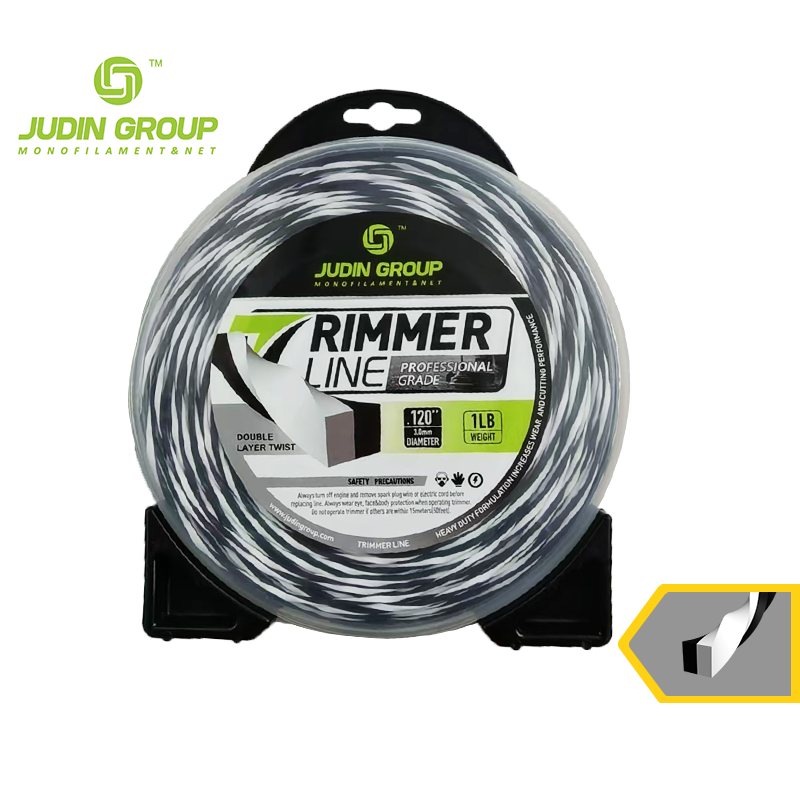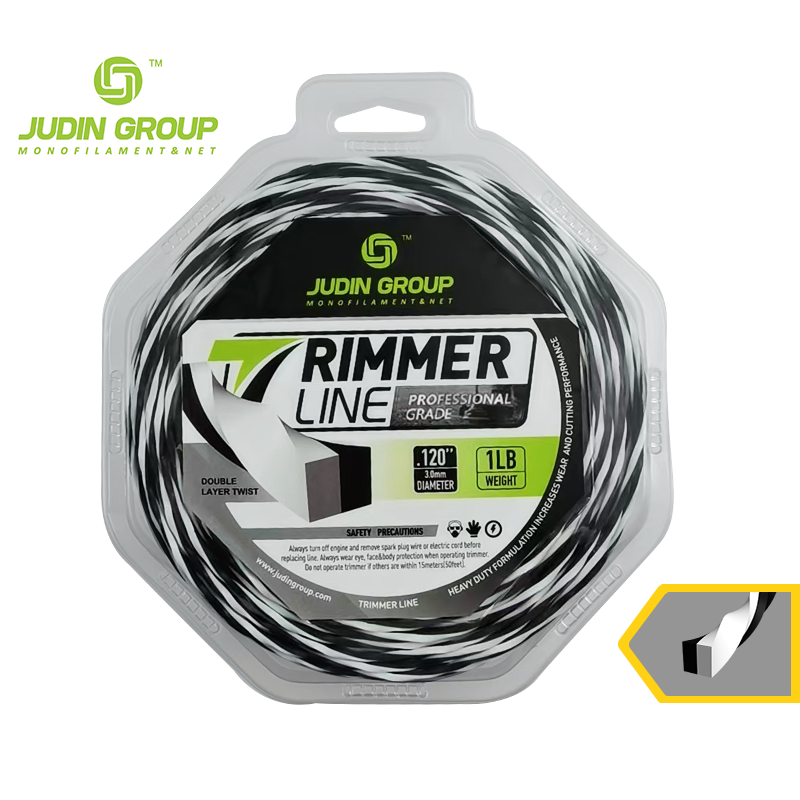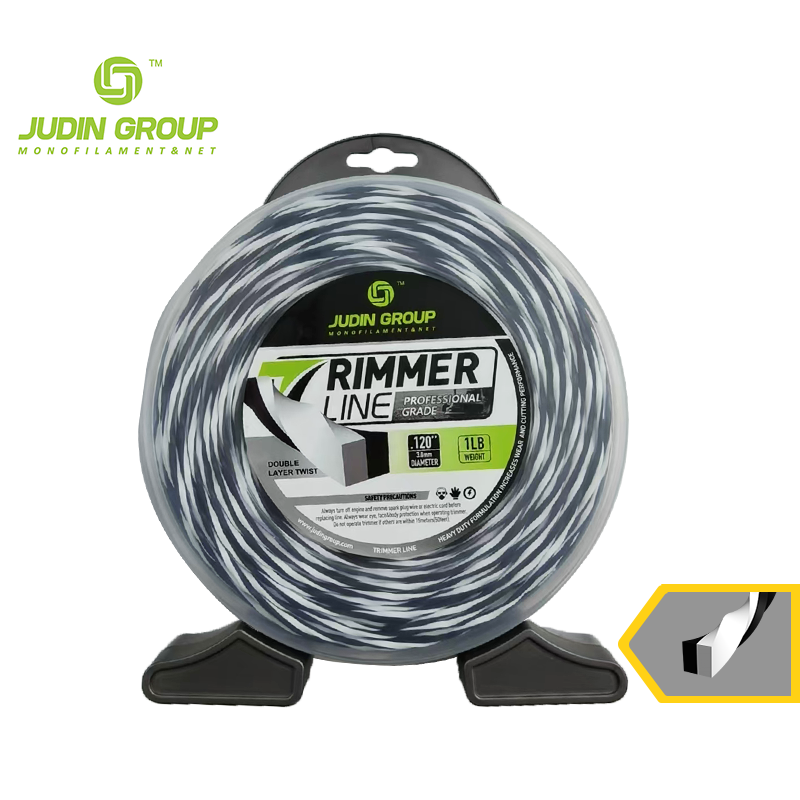Tackling thick weeds can feel like a battle, but the right tools make all the difference. Choosing the perfect trimmer line is key to cutting through stubborn vegetation with ease. Focus on three things: thickness, material, and compatibility. These factors ensure your trimmer works efficiently, saving you time and effort.
Key Takeaways
- Picking the right trimmer line helps cut thick weeds better. Look at thickness, material, and shape to improve results.
- For tough jobs, pick a thicker line, 0.105 to 0.130 inches. This makes it last longer and less likely to snap.
- Always read your trimmer’s manual to find the right line. Using the wrong one can harm your trimmer and cut poorly.
Types of Trimmer Lines and Their Impact
Common Shapes and Their Uses
When it comes to trimmer lines, their shape plays a big role in how they perform. You might not think much about it, but the shape of the line can make a huge difference in cutting efficiency and the type of vegetation it can handle. Here are some common shapes and what they’re best for:
- Round: This is the most basic shape. It’s durable and works well for light trimming tasks like grass and small weeds. However, it may struggle with thicker vegetation.
- Twisted: Twisted lines are stronger and quieter. They’re great for medium to heavy-duty tasks and can handle tougher weeds without breaking easily.
- Square: Square-shaped lines have sharp edges that slice through thick weeds and brush. If you’re dealing with stubborn overgrowth, this is a solid choice.
- Star or Multi-sided: These lines have multiple cutting edges, making them perfect for professional use. They’re designed to tackle the toughest jobs with precision.
Tip: If you’re unsure which shape to choose, think about the type of vegetation you’ll be trimming most often. For thick weeds, square or twisted lines are usually your best bet.
Materials and Durability
The material of your trimmer line affects its strength and lifespan. Most lines are made from nylon, but not all nylon is created equal. Here’s a quick breakdown:
- Standard Nylon: Affordable and good for light-duty tasks. It’s not as durable for heavy use.
- Reinforced Nylon: This type includes additives like aluminum or polymers to increase strength. It’s ideal for tougher jobs.
- Double-Layered Nylon: Products like the Judin .120 inch Double Layer Twist Blister-5 use 100% new nylon material. This ensures exceptional durability and performance, even for professional use.
Some trimmer lines also come with coatings to reduce wear and tear. These coatings help the line last longer, especially when used on abrasive surfaces like concrete or rocks.
How Shape and Material Influence Cutting Efficiency
The combination of shape and material determines how well your trimmer line performs. For example, a twisted line made from reinforced nylon will cut more efficiently than a round line made from standard nylon. Here’s why:
- Shape: Lines with sharp edges, like square or star shapes, slice through vegetation instead of tearing it. This reduces strain on your trimmer and makes the job faster.
- Material: High-quality materials, like double-layered nylon, resist breaking and fraying. This means you’ll spend less time replacing the line and more time trimming.
Note: Using the right trimmer line not only improves cutting efficiency but also extends the life of your trimmer. A durable line reduces the load on your equipment, saving you money in the long run.
By understanding the impact of shape and material, you can choose a trimmer line that matches your needs. Whether you’re a weekend gardener or a professional landscaper, the right line makes all the difference.
Choosing the Right Thickness for Tough Weeds
Recommended Thickness for Heavy-Duty Tasks
When you’re up against thick weeds or dense overgrowth, the thickness of your trimmer line can make or break your success. For heavy-duty tasks, a thicker line—typically between 0.105 inches and 0.130 inches—is your best bet. This range provides the strength and durability needed to handle tough vegetation without snapping or wearing out quickly.
Thicker lines are especially useful for professional landscapers or anyone maintaining large properties. They can cut through stubborn weeds, tall grass, and even light brush with ease. If you’re dealing with particularly challenging areas, opting for a line on the higher end of this range, like 0.120 inches, ensures you have the cutting power to get the job done efficiently.
Pro Tip: Always check your trimmer’s user manual to confirm the maximum line thickness it can handle. Using a line that’s too thick for your equipment can reduce performance or even damage your trimmer.
Examples of Durable Trimmer Lines (e.g., Judin .120 inch Double Layer Twist Blister-5)
Not all trimmer lines are created equal, and finding one that combines thickness with durability is key. A great example is the Judin .120 inch Double Layer Twist Blister-5. This trimmer line is specifically designed for heavy-duty tasks, making it a reliable choice for tackling thick weeds and overgrowth.
What sets this line apart is its six-pronged cutting surface, which increases the contact area for more efficient cutting. Made from 100% new nylon material, it offers exceptional strength and longevity. Whether you’re clearing out a neglected yard or maintaining a professional landscape, this line delivers consistent performance. Plus, its symmetrical design ensures stability during high-speed rotation, so you can trim with precision and confidence.
If you’re looking for versatility, the Judin line comes in various sizes and weights, catering to different mowing needs. It’s a smart investment for anyone who wants a durable, high-performing trimmer line that won’t let them down.
How Thickness Enhances Cutting Power and Longevity
You might wonder why thickness matters so much. A thicker trimmer line doesn’t just cut better—it also lasts longer. Here’s how:
- Increased Cutting Power: Thicker lines have more mass, which means they can generate greater force when spinning. This allows them to slice through tough vegetation instead of tearing it, making your trimming tasks faster and more efficient.
- Reduced Breakage: Thin lines are more prone to snapping, especially when they hit hard surfaces like rocks or fences. A thicker line can withstand these impacts, saving you the frustration of frequent replacements.
- Extended Lifespan: Because thicker lines are more durable, they wear down more slowly. This means you can spend more time trimming and less time reloading your spool.
Did You Know? Using a high-quality, thick trimmer line like the Judin .120 inch Double Layer Twist Blister-5 not only improves cutting performance but also reduces the strain on your trimmer. This can help extend the life of your equipment, making it a win-win for your lawn care routine.
By choosing the right thickness, you can tackle even the most stubborn weeds with ease. Whether you’re a weekend warrior or a seasoned pro, investing in a durable, thick trimmer line ensures your trimming tasks are smooth and hassle-free.
Factors to Consider When Selecting a Trimmer Line
Matching the Line to Vegetation Type
Choosing the right trimmer line starts with understanding the type of vegetation you’ll be cutting. Different weeds and grasses require different levels of cutting power. For light tasks like trimming grass or small weeds, a thinner, round line works well. If you’re dealing with thick weeds or overgrown brush, opt for a thicker, square or twisted line. These shapes and sizes provide the strength and sharpness needed to slice through stubborn vegetation.
Tip: Take a walk around your yard before buying a trimmer line. Look closely at the vegetation to decide what kind of cutting power you’ll need.
Ensuring Compatibility with Your Trimmer
Not all trimmer lines fit every trimmer. Before you buy, check your trimmer’s user manual for the recommended line thickness and type. Using an incompatible line can reduce performance or even damage your equipment. Many trimmers are versatile and can handle multiple line types, but it’s always better to double-check.
If you’re unsure, visit your local hardware store with your trimmer model details. The staff can help you find a line that matches perfectly.
Balancing Performance and Budget
Finding the right balance between performance and cost is key. High-quality lines, like those made from reinforced or double-layered nylon, last longer and cut better. While they may cost more upfront, they save you money in the long run by reducing replacements. On the other hand, if you’re only trimming occasionally, a standard nylon line might be enough.
Pro Tip: Invest in a durable line if you’re tackling tough weeds regularly. It’s worth the extra cost for better results and fewer headaches.
Tips for Maximizing Trimmer Line Performance
Proper Installation and Maintenance
Installing your trimmer line correctly is the first step to getting the best performance. Always follow the instructions in your trimmer’s manual. Make sure the line is wound tightly and evenly on the spool. A loose or uneven line can cause poor cutting and even damage your trimmer.
After installation, check the line regularly. Look for signs of wear, like fraying or thinning. Replace it as soon as you notice these issues. Keeping your trimmer clean also helps. Grass clippings and dirt can build up and affect how the line spins. Wipe down the spool and cutting head after each use to keep everything running smoothly.
Best Practices for Trimming Thick Vegetation
When tackling thick weeds, technique matters. Start by trimming at a steady pace. Don’t rush or force the trimmer into dense areas. Let the spinning line do the work. For best results, hold the trimmer at a slight angle and move it side to side. This ensures even cutting and prevents the line from wearing out too quickly.
Avoid hitting hard surfaces like rocks or fences. These can snap the line or cause it to fray. If you’re working near obstacles, slow down and trim carefully. This not only protects the line but also improves your overall trimming precision.
Extending the Lifespan of Your Trimmer Line
Want your trimmer line to last longer? Store it properly. Keep it in a cool, dry place away from direct sunlight. Heat and moisture can weaken the material over time. Some people even soak their line in water before use. This keeps it flexible and less likely to break.
Using the right line for the job also makes a big difference. A high-quality line, like the Judin .120 inch Double Layer Twist Blister-5, is designed to handle tough weeds and last longer. Investing in durable options saves you time and money in the long run.
Choosing the right trimmer line makes tackling tough weeds much easier. It saves you time, effort, and frustration. By understanding your needs and investing in high-quality options like Judin’s trimmer line, you’ll enjoy better results and a longer-lasting tool. Make an informed choice and see the difference for yourself!
 |
 |
 |
FAQ
What’s the best trimmer line for thick weeds?
The Judin .120 inch Double Layer Twist Blister-5 is perfect. Its six-pronged design and durable nylon material make cutting stubborn weeds a breeze.
Can I use any trimmer line with my equipment?
No. Check your trimmer’s manual for compatible thickness and type. Using the wrong line might reduce performance or damage your tool.
How do I make my trimmer line last longer?
Store it in a cool, dry place. Soaking it in water before use keeps it flexible and less likely to break.
Post time: May-27-2025







